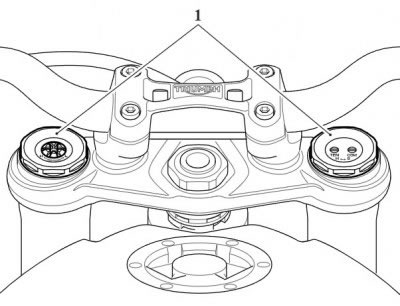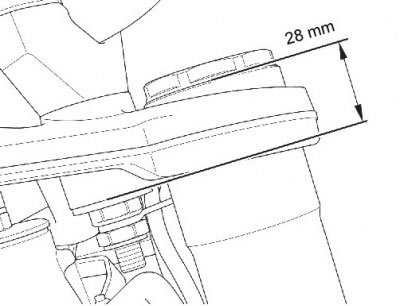Warning!
- Make sure the motorcycle is stabilised and adequately supported.
- A correctly supported motorcycle will help prevent it from falling.
- An unstable motorcycle may fall, causing injury to the operator or damage to the motorcycle.
Note: When positioning the front forks to the yokes, make sure the fork top caps are correctly aligned as shown below.

1. Fork top caps (correctly aligned)
1. Position the forks within the yokes so that the lip of the outer tube, not the top cap, is 28 mm above the flat/machined surface on the underside of the upper yoke.

Fork pull through measurement
2. Tighten the lower yoke pinch bolts as follows:
- tighten the upper bolt to 22 Nm
- tighten the lower bolt to 22 Nm
- re-tighten the upper bolt to 22 Nm.
3. Tighten the upper yoke pinch bolts to 26 Nm.
Caution! Before tightening, cover the fork top cap with a suitable masking tape to protect its anodized finish from becoming damaged by the tool.
4. If the forks have been dismantled, tighten the fork top caps to 35 Nm.
Note: Recheck the fork top caps for correct alignment as shown above. If necessary, loosen the upper and lower yoke pinch bolts and adjust the top cap alignment as required. Re-tighten the upper and lower yoke pinch bolts as described above.
Perform the following operations:
- Front abs wheel speed sensor - installation
- Front mudguard - installation
- Front wheel - installation
- Front brake caliper - installation
Note: The air gap between the ABS pulser ring and the wheel speed sensor must be between 0.40 mm to 1.20 mm.
- Check, and if necessary, adjust the front ABS sensor air gap (see Front ABS sensor air gap measurement).
- Lower the motorcycle to the ground and park it on the side stand.
